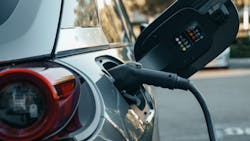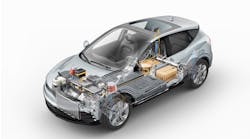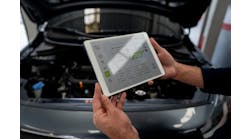About two years ago, Matt Lofton began to think about adding an electric vehicle (EV) charging station at his auto shop in Roxboro, N.C.
Although Strut Daddy’s Complete Car Care is in a rural community, Lofton set a goal of servicing more EVs and hybrids in the near future. So, this past October, he invested about $1,000 to install a Level 2 charger, the middle tier of devices in terms of cost, charging speed and power consumption.
“This isn’t a huge EV market at the moment, but it’s also not uncommon to see one anymore,” he says. “Things are changing, and I feel like the handwriting is on the wall. Having it just opens the door to customers feeling like they can trust us to fix an EV.”
As the number of non-gasoline vehicles increases in the United States, auto shops across the country have made a similar decision. However, other owners have determined there aren’t yet enough pros—and too many cons—to justify the expense of a charging station.
Gas-powered vehicles still make up roughly 98% to 99% of vehicles on American roadways, but the EV share of total new car sales jumped sharply between 2020 and 2022. Now at about 5%, that figure could increase to 25% to 30% percent by 2030 and 40% to 45% by 2035, according to estimates from IHS Markit, an international information services provider.
For auto shops in metro markets, near highways or in green-leaning communities, the question of adding a charging station can be simpler.
Breaking Down the Cost-Risk Analysis
Costs for EV chargers are in the $1,000 to $2,600 range per port and in some states and tax savings for adding chargers can greatly reduce or even virtually eliminate the expense. Arizona had a $1,500 per-port rebate for Level 2 chargers in 2022, for example, while in Texas, Austin Energy will cover 50% of the cost for commercial customers.
Some business owners feel having a charger is a good advertisement for potential customers; others consider the investment more about service. Seth Thorson, owner of four Eurotech Auto Service shops in Minnesota, has had an EV station at one of his locations since 2014 and plans to have two at each in the near future.
Eurotech Auto not only maintains and repairs EVs but uses them for its shuttle vehicles, a cost-saver over gasoline models. Thorson also has five EVs in his family.
“Generally, I think you need to deliver a car back with at least as much of a charge as it came in with,” he says. “In fact, the customer may even be relying on that to get back home.” Additionally, technicians can help customers determine if an at-home charger isn’t working or – if a vehicle also won’t charge at the shop–the problem is with the car.
Lofton agrees that customer benefits outweigh the relatively minimal financial risk. “If you do repairs on a gas-powered vehicle and need to test it, you take it to a gas station and fill it up if you have to,” he noted. “Same with an EV with a low battery: you want to be able to charge it before testing it out. It’s also good service to return a car fully charged.”
There can still be a few downsides, however.
Charging stations can take up a full parking space, not an insignificant problem for businesses with already-crowded lots. If a shop likely won’t see many EVs soon—often a reality given the longer lifespan of many gas-powered vehicles today—the investment may not yet make sense.
And even for businesses that do plan to venture into EV repairs, more pressing needs such as specialized training and equipment may take precedence.
Shops that do add EV chargers almost universally opt for Level 2 devices, which normally operate on a dedicated 240-volt circuit. While achieving a full charge could take four or more hours, the chargers are effective for topping off an EV with a low battery. Per-month costs, which vary based on usage, don’t tend to climb very high.
Level 1 chargers, which typically plug into a common 120-volt household outlet, are much slower and often used for plug-in hybrids with a backup gasoline engine. Level 3 superchargers, meanwhile, are up to 15 times faster than Level 2 chargers but can cost tens or even hundreds of thousands of dollars, require a 480-volt electrical source and eat up a lot of power.
‘It’s a Hot Topic’
For shop operators who drive EV vehicles, part of having a charging port is personal convenience. Jay Huh, owner of Carmedix in Durham, N.C., has bought three Teslas to date, part of a recent surge of EV purchases in the technology-rich Raleigh-Durham area.
Huh installed a charging station at Carmedix two years ago, initially mainly so he could power his cars. But last year, the business began aggressively marketing its EV services, launching a direct mail campaign and creating a YouTube video that racked up 10,000 views in four days.
“There’s definitely a demand for EV shops that’s growing, and that’s true here where my shop is,” Huh says. “It’s a hot topic, so to me having the charger is an important part of expanding this part of our business.”
At Strut Daddy’s, the new EV charger is a wall-mounted unit inside one of the business’ bay doors, with a cord that stretches outside. It doesn’t take up much space, but it already has become a conversation piece.
“We have no regrets,” Lofton says. “It’s still an emerging technology and we even might be three to five years away from serving a large number of EVs. But when it happens, we’re going to be ready.”



